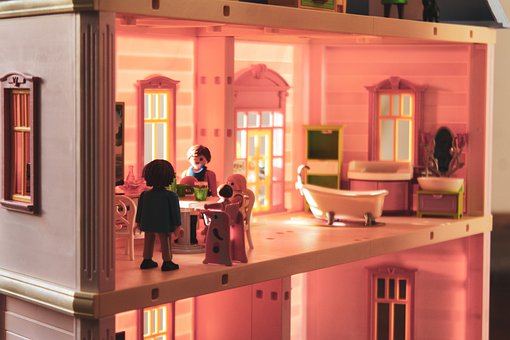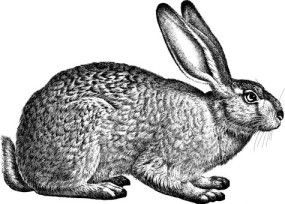
The Doll’s House by Katherine Mansfield, published in 1922, is a short story written in third-person, through an omniscient narrator. It discusses societal class and ostracization through the lens of two sets of school-going sisters from different family backgrounds.
The Doll’s House | Summary
The story starts with Mrs. Hay- a previous guest at the Burnell’s residence- sending a lovely, large dollhouse as a gift to the family’s three daughters- Isabel, Lottie, and Kezia. It smelled of paint, but the decorations and detail were perfect, and the girls were thrilled. The youngest sister, Kezia, especially loved the little amber lamp with its white globe, standing in the middle of the dining table. She thought the dolls looked too large and unnatural for the dollhouse- meanwhile, it was the tiny lamp that seemed to fit perfectly, as though it was meant to live there.
The Burnell sisters were already popular at school, being from a family that was relatively well-off for their location. In fact, their mother disapproved of the school, for the girls had to mix with the children of grocers and milkmen. However, she allowed the sisters to bring their friends home two by two to see the dollhouse. When Isabel explained the dollhouse to their friends, Kezia felt she was not giving nearly enough importance to the little lamp- but it did not matter, as Isabel was the one choosing the first two visitors. The only girls who did not participate in this excitement were Lil and Else Kelvey- they sat outside the circle and listened in without saying a word. Those two sisters were social outcasts- their mother was a washerwoman and their father was allegedly in prison. Else never said a word, quietly following Lil’s lead. Many parents, including the Burnell sisters, forbid their children from mingling with them.
As days passed, the Burnell’s dollhouse became the talk of the school. Everyone had visited and admired it and discussed it eagerly in class the next day. As usual, the Kelveys sat on the outside looking in. Kezia asked her mother one day if she may invite the Kelveys, but she was firmly turned down, with her mother saying, “You know why not.” In the end, the Kelveys were the only ones who hadn’t been invited to see the dollhouse, and it turned the school’s attention onto them. One day, the schoolgirls were being especially rude to the two sisters, a girl named Lena even asking Lil if she would be a servant when she grew up. Lil did not pay heed, which infuriated Lena into making a comment about the Kelveys’ apparent criminal father. The other girls shrieked with shock and excitement and went to play jump rope with a renewed vigor.
A few days later, when the Burnell girls were getting ready for a visitor, Kezia saw the Kelvey sisters walking near her house’s gate. She quietly opened it and beckoned them in, asking if they wanted to see the dollhouse. They refused, as their mothers said the Burnell’s weren’t allowed to speak to them. But at Kezia’s firm insistence, they stepped foot into the courtyard. Lil and Else were able to get a view of the dollhouse, and even briefly saw its interior before Kezia’s Aunt Beryl appeared and furiously shooed them away. Aunt Beryl was already in a bad mood because she received a letter from William Brent demanding he meet her at midnight, otherwise he would turn up at her door. The pressure of the letter vanished after she frightened the Kelveys and scolded Kezia.
Meanwhile, the two Kelvey sisters were out of sight from the Burnell’s house. They sat on a drainpipe and gazed into the distance in silence, almost dreamily. They had already forgotten the scolding of Aunt Beryl- their mind was fixed on the dollhouse they finally managed to see. It was Else who spoke, for the first time in the story, saying that she had seen the little lamp. The two continued to sit in silence.
The Doll’s House | Analysis
Katherine Mansfield, born and raised in New Zealand, was one of the most famous writers of her time. She often wrote in third-person and portrayed elements of her personal experiences. The theme of her work usually matched the situation she was undergoing in her own life. The Doll’s House is written in third-person using an omniscient narrator, and it translates the nuances of very deep elements in an insightful yet simple way. The main themes are class prejudice, social hierarchy and ostracization, and innocence. Because the main characters are young schoolgirls, these topics are put forth in a rather straightforward manner- after all, young children have far less direct awareness or conscience, and their way of thinking is often precise. However, we also see the cruelty of this forthrightness in the way the children do not hesitate to bully and mock their classmates of a lower social sphere. This shows the normalization of treatment based on hierarchy, as well as the influence of society on children’s mindsets. Similes, metaphors and imagery are employed throughout this piece.
Mansfield also uses object symbolism to portray key aspects of the story. Starting from the very beginning, when the Burnell girls are gifted a dollhouse, Mansfield establishes the concept of social class. The dollhouse is a direct representation of the Burnell’s own house– it is large, the girls are thrilled by it, and it seems furnished to the detail. However, its description is not entirely flattering- “a dark, oily, spinach green, picked out with bright yellow” and “the smell of paint coming from that doll’s house was quite enough to make anyone seriously ill.” Further, it is important to note “When dear old Mrs. Hay went back to town after staying with the Burnells, she sent the children a doll’s house.” This implies that the Burnells themselves do not live in the central part of town, but in the outskirts. Hence, the dollhouse symbolizes that though the Burnells may not be extremely rich on a large scale, they are well-to-do and of a higher social class within their area of residence.
The fact that when the sisters went to school and Isabel talked about the dollhouse is also a portrayal of the automatic respect and flattery given to those with more money or at a higher rank :
“The girls of her class nearly fought to put their arms round her, to walk away with her, to beam flatteringly, to be her special friend.”
This emphasizes the superficiality of these advances- none of the girls wanted to spend time with Isabel because they liked her as a person. They did not want to be her ‘special friend’ because they enjoyed her company. It was simply out of the eagerness to see the magnificent dollhouse. At this time, the Kelvey sisters being left out represents the lower rung of the social hierarchy. The fact that it is the other children’s parents who forbid them from mingling with Else and Lil showcases how society and adults can impact a child’s behavior. For example, “For the fact was, the school the Burnell children went to was not at all the kind of place their parents would have chosen if there had been any choice.”– this automatically instills in the Burnell children a superiority complex.
Else never spoke and stuck close to her sister Lil- “Where Lil went, our Else followed.”- which shows the demure nature. It also emphasizes a level of acceptance from both of them- they never tried to fight back or defend themselves as they knew nothing would come of it, but simply ignored the mocking and jeers and moved on. They seem to have realized that things will not change, and they are stuck in the social class they were born into. The fact that these girls have understood this and cope with it at such a young age makes the reader realize how normalized it is, which is quite unfortunate. The description of Lil and Else sitting outside the circle of schoolgirls and constantly having to listen in is a direct depiction of being socially ostracized– closed off, on the outside looking in.
Kezia, the youngest Burnell sister, is the only one of the family- of the whole school, maybe- who questions the social ostracization of the Kelveys. She wants to invite the sisters home to show them the dollhouse, as well- her youth and innocence put everyone on a level playing field. While the rest of her family sees things from the perspective of social status and financial importance, she simply sees everyone as people. She views the world in a more wholesome manner. When she sees the Kelvey sisters near her house, she is swinging on the white gate of her house. This white gate is what separates the Burnells from the outside world, trapping them in their bubble of greater wealth and societal class. As a material divide between the Burnells and the rest of the area, the gate represents the separation of the social spheres. Kezia swings on it back and forth, teetering on the edge of this imposed border, which symbolizes her different outlook. Unlike her family, she does not understand why the Kelveys are kept at a distance.
When the family receive the dollhouse, Kezia alone fixates on the tiny lamp–
“The father and mother dolls, who sprawled very stiff as though they had fainted in the drawing-room, and their two little children asleep upstairs, were really too big for the doll’s house. They didn’t look as though they belonged. But the lamp was perfect. It seemed to smile at Kezia, to say, “I live here.” The lamp was real.”
This lamp is symbolic of innocence and hope. It does not stand out extraordinarily, which is why none of the older sisters or adults find it interesting. Yet its gentle, modest appearance is what draws Kezia to it- this highlights a younger child’s perspective. The lamp is a form of hope for Kezia and the Kelvey sisters- for after being chased away by Aunt Beryl, Else smiles for the first time and says, “I seen the little lamp.” It is an unspoken bond between Else and Kezia- that they are able to see beyond the discrimination of the adults in the society. They notice and appreciate the same things- a small detail like a lamp, rather than the grandeur of the rest of the dollhouse. Their youth stops them from fully comprehending the reason for this class divide, but their innocent and open-minded attitude forms a ray of hope that even when they are older, they will be able to see everyone as human rather than by social status.


